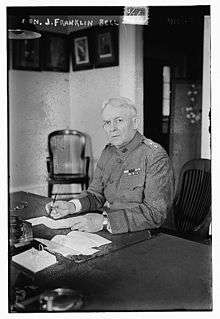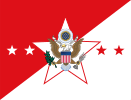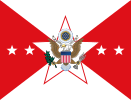J. Franklin Bell
James Franklin Bell (January 9, 1856 – January 8, 1919) was an officer in the United States Army who served as Chief of Staff of the United States Army from 1906 to 1910.
James Franklin Bell | |
|---|---|
 Major General J. Franklin Bell in 1917 | |
| Born | January 9, 1856 Shelbyville, Kentucky |
| Died | January 8, 1919 (aged 62) New York City, New York |
| Allegiance | United States |
| Service/ | United States Army |
| Years of service | 1878–1919 |
| Rank | Major General |
| Commands held | Chief of Staff of the United States Army Philippine Department Department of the East 77th Infantry Division |
| Battles/wars | Indian Wars
World War I |
| Awards | Medal of Honor Distinguished Service Cross Distinguished Service Medal |
Bell was a major general in the Regular United States Army, commanding the Department of the East, with headquarters at Governors Island, New York at the time of his death in 1919. He entered West Point in 1874, and graduated 38th in a class of 43 in 1878, with a commission as second lieutenant of the 9th Cavalry Regiment, a black unit.
Early life
Bell was born to John Wilson and Sarah Margaret Venable (Allen) Bell in Shelbyville, Kentucky. His mother died when he was young. Thereafter the two most important women in his life were the black woman who looked after him as a child and the white woman who became his step-mother.[1]
During the American Civil War, Shelby County was split between Union and Confederate factions. The extended Bell family was strongly in favor of the secession. After the firing on Fort Sumter, John Wilson Bell and his brothers drew lots to determine who would remain at home to look after their parents and who would join the Southern armies. John lost and remained at home. Young James Franklin, "Frank" as he was known to family and friends, thus grew up in a milieu in which slavery was not only accepted and practiced but strongly defended.
Bell attended the public schools in Shelbyville. Until he was sixteen, he also worked on his father's farm six days a week with breaks only for school and the Sabbath. In the process, he developed a strong physical constitution that stood him in good stead for the remainder of his life. In 1872 he began working as a clerk in a general store owned by one of his uncles. His chief recreations were baseball and horse racing. One neighbor later remembered Frank and a friend tearing down country lanes on horseback "as if the Devil" was after them.[2]
Working in a general store did not appeal to such a high spirited young person, and in 1874 he secured appointment to West Point. During his four years at the Military Academy, he excelled in art, horsemanship, demerits, and making friends. He graduated 38th in a class of 43. The War Department assigned him to the 9th Cavalry, one of the black units formed after the Civil War. Then in Kentucky on home leave, Bell attempted to resign his commission. This, in fact, was illegal, but someone at the War Department understood the attitudes that were behind this action and assigned him to the all-white 7th Cavalry. He joined the unit at Fort Abraham Lincoln, Dakota Territory, on October 1, 1878.[3]
Indian Wars
Bell became an instructor of military science and tactics and taught mathematics at Southern Illinois University, a position held from 1886 until 1889. While in Illinois, he read law and passed the Illinois bar. In 1889, he returned to the 7th Cavalry. Although the regiment participated in the Wounded Knee Massacre in South Dakota, Bell was on personal leave and did not participate. He was promoted to first lieutenant on December 29, 1890, and participated in the Pine Ridge, South Dakota campaign in 1891. Later that year, the 7th Cavalry was posted to Fort Riley, Kansas, and Bell joined the staff of the Cavalry and Light Artillery School. He soon became adjutant, then secretary of the school. In November 1894, Bell became aide-de-camp to General James W. Forsyth and posted to the Department of California. He was transferred to Fort Apache, Arizona Territory, in July 1897 and then to Vancouver Barracks, Washington, in February 1898.
Spanish–American War
At the outbreak of the Spanish–American War, Bell was acting as adjutant to General Forsyth, then commanding the Department of the West, with headquarters at San Francisco. He was immediately commissioned Colonel of Volunteers, and authorized to organize a regiment. This regiment was ordered to the Philippines and, under his command, saw service in the Philippine–American War.
After a few months in the Philippines, Bell was promoted from his commission of captain in the Regular Army to brigadier general in the Regular Army, outranking many officers previously his senior.
Bell was awarded a Medal of Honor for his actions of September 9, 1899 near Porac on Luzon Island in the Philippines. According to the official citation, "while in advance of his regiment [Bell] charged 7 insurgents with his pistol and compelled the surrender of the captain and 2 privates under a close fire from the remaining insurgents concealed in a bamboo thicket."[4]
Service in America
In July 1903, Bell was transferred to Fort Leavenworth, Kansas, where he headed the Command and General Staff School until April 14, 1906; Bell was promoted major general, and was appointed Chief of the Army General Staff. He served for four years, under Presidents Theodore Roosevelt and William Howard Taft. Bell was the first chief officer of the United States Army in 45 years who had not served in the American Civil War.

When the United States military forces of the Western Pacific concentrated in the Philippines, he returned to Manila in 1911, as military commander, until war with Mexico seemed imminent. He was then ordered home to take command of the 4th Division. The 4th Division remained in Texas City as reserve and, although at several times he seemed about to cross the Rio Grande, he was never a part of the Mexican expeditionary force.
After the Mexican situation quieted, Bell was relieved of the 4th Division, and placed in command of the Department of the West. He remained in command at San Francisco, where he had once been acting adjutant, until the United States entered World War I.
In the early spring of 1917, Bell was transferred to the Department of the East at Fort Jay, Governors Island, in New York City, and as commander of that department, assuming responsibility for Officers' Training Camps created by his predecessor, Leonard Wood, at Plattsburgh, Madison Barracks, and Fort Niagara. Bell's aide, Captain George C. Marshall, was most directly involved in the logistical support for these camps, battling a lethargic army supply system to properly equip the volunteer citizen soldiers. These camps, in August 1917, graduated the large quota of new officers needed for the new National Army and, to a large extent, to officer the new divisions of the east and northeast.
In the same month, Bell was offered and promptly accepted the command of the National Army Division to be organized at Camp Upton. Bell commanded the Division when the first newly appointed officers climbed the hill and reported to their first assignment, through that formative stage when barracks were thrown together at a miraculous speed, and being filled at the same rate. Then, in December, he sailed for France to make a tour of the front, and observe, first hand, actual fighting conditions. He did not return until the latter part of March 1918.
On his return, Bell failed the physical examination required for active service overseas. When the doctors decreed that he would not take his division to France, Bell was again given command of the Department of the East, and returned to his old headquarters, Governors Island, which command he held until his death in January 1919.
Awards and decorations
- Medal of Honor
- Distinguished Service Cross[5]
- Distinguished Service Medal
- Indian Campaign Medal
- Spanish Campaign Medal
- Philippine Campaign Medal
- World War I Victory Medal
Medal of Honor citation
Rank and organization: Colonel, 36th Infantry, U.S. Volunteers. Place and date: Near Porac, Luzon, Philippine Islands, September 9, 1899. Entered service at: Shelbyville, Ky. Born: January 9, 1856, Shelbyville, Ky. Date of issue: December 11, 1899.
- Citation
While in advance of his regiment charged 7 insurgents with his pistol and compelled the surrender of the captain and 2 privates under a close fire from the remaining insurgents concealed in a bamboo thicket.
Dates of rank
![]()
| Rank | Date | Component |
|---|---|---|
| June 1878 | Regular Army | |
| 29 December 1890 | Regular Army | |
| 17 May 1898 | Volunteers | |
| 2 March 1899 | Regular Army | |
| 5 July 1899 | Volunteers | |
| December 1899 | Volunteers | |
| 19 February 1901 | Regular Army | |
| 3 January 1907 | Regular Army |
References
- Ltr, Maj Gen J. Franklin Bell to Maj Gen Hugh L. Scott, September 30, 1915, Hugh L. Scott Mss., Library of Congress, Washington, D.C.
- Shelby News, May 10, 1906; E. A. Garlington, "James Franklin Bell," Fiftieth Annual Report of Association of Graduates, United States Military Academy (Saginaw, Mich., 1919), pp. 162–63.
- Ltr, 2d Lt J. Franklin Bell to The Adjutant General, August 9, 1878, Adjutant General Correspondence, 1890–1917, 3773 Appointment, Commission, Promotion (ACP) 78 filed with 937 ACP 79, Record Group (RG) 94, National Archives and Records Service (NARA), Washington, D.C.; Ltr, 2d Lt J. Franklin Bell to Col E. F. Townsend, November 19, 1890, 6842 ACP 90 filed with 937 ACP 79, RG 94, NARA.
- CMH Archived June 7, 1997, at the Wayback Machine at www.army.mil
- Military Times Hall of Valor Archived 2014-07-14 at the Wayback Machine – Bell was the first person to earn both the MOH and the DSC
Further reading
- The Philippine "Lodge committee" hearings (A.K.A. Philippine Investigating Committee) and a great deal of documentation were published in three volumes (3000 pages) as S. Doc. 331, 57th Cong., 1st Session An abridged version of the oral testimony can be found in: American Imperialism and the Philippine Insurrection: Testimony Taken from Hearings on Affairs in the Philippine Islands before the Senate Committee on the Philippines-1902; edited by Henry F Graff; Publisher: Little, Brown; 1969. ASIN: B0006BYNI8
- See the extensive Anti-imperialist summary of the findings of the Lodge Committee/Philippine Investigating Committee on wikisource. Listing many of the atrocities and the military and government reaction.
- Ramsey, Robert D. III "A Masterpiece of Counterguerilla Warfare: BG J. Franklin Bell in the Philippines, 1901–1902", The Long War Series: Occasional Paper 25 Fort Leavenworth: Combat Studies Institute Press 2007 ISBN 978-0-16-079503-9
- Raines, Edgar F., Jr. "Major General J. Franklin Bell, U.S.A.: The Education of a Soldier, 1856-1899," Register of the Kentucky Historical Society 83 (Autumn 1985): 315–46.
- Davis, jr., Henry Blaine (1998). Generals in Khaki. Raleigh, North Carolina: Pentland Press, Inc. pp. 30–31. ISBN 1-57197-088-6.
External links
- "The Burning of Samar". Archived from the original on September 5, 2008. Retrieved September 29, 2010. *James Franklin Bell at Find a Grave
| Military offices | ||
|---|---|---|
| Preceded by John C. Bates |
Chief of Staff of the United States Army 1906–1910 |
Succeeded by Leonard Wood |
| Preceded by Charles W. Miner |
Commandant of the Command and General Staff College 1903–1906 |
Succeeded by Charles Badger Hall |

